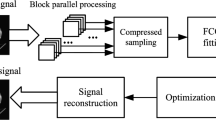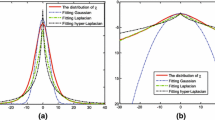Abstract
In this paper, the medical CT image blind restoration is translated into two sub problems, namely, image estimation based on dictionary learning and point spread function estimation. A blind restoration algorithm optimized by the alternating direction method of multipliers for medical CT images was proposed. At present, the existing methods of blind image restoration based on dictionary learning have the problem of low efficiency and precision. This paper aims to improve the effectiveness and accuracy of the algorithm and to improve the robustness of the algorithm. The local CT images are selected as training samples, and the K-SVD algorithm is used to construct the dictionary by iterative optimization, which is beneficial to improve the efficiency of the algorithm. Then, the orthogonal matching pursuit algorithm is employed to implement the dictionary update. Dictionary learning is accomplished by sparse representation of medical CT images. The alternating direction method of multipliers (ADMM) is used to solve the objective function and realize the local image restoration, so as to eliminate the influence of point spread function. Secondly, the local restoration image is used to estimate the point spread function, and the convex quadratic optimization method is used to solve the point spread function sub problems. Finally, the optimal estimation of point spread function is obtained by iterative method, and the global sharp image is obtained by the alternating direction method of multipliers. Experimental results show that, compared with the traditional adaptive dictionary restoration algorithm, the new algorithm improves the objective image quality metrics, such as peak signal to noise ratio, structural similarity, and universal image quality index. The new algorithm optimizes the restoration effect, improves the robustness of noise immunity and improves the computing efficiency.
Similar content being viewed by others
References
Jiang, M., Wang, G., Skinner, M.W., and Rubinstein, J.T., Blind deblurring of spiral CT images, IEEE Trans. Med. Imaging, 2003, vol. 22, pp. 837–845.
Xu, J., Taguchi, K., and Tsui, B.M., Statistical projection completion in X-ray CT using consistency conditions, IEEE Trans. Med. Imaging, 2010, vol. 29, pp. 1528–1540.
Sun, Y., Zhang, L., Zhang, J., and Shi, L., Neural network blind equalization algorithm applied in medical CT image restoration, Math. Probl. Eng., 2013, vol. 28, pp. 151–164.
Sun, Y., Zhang, L., and Zhang, H., Complex system blind equalization algorithm for equivalent multichannel CT image restoration, J. Med. Imaging Health Inf., 2016, vol. 6, pp. 555–561.
Pakdel, A., Mainprize, J.G., Robert, N., Fialkov, J., and Whyne, C.M., Model-based PSF and MTF estimation and validation from skeletal clinical CT images, Med. Phys., 2014, vol. 1, no. 41, p. 011906.
Taniguchi, T., Akamatsu, G., Kasahara, Y., Mitsumoto, K., Baba, S., and Tsutsui, Y., Improvement in PET/CT image quality in overweight patients with PSF and TOF, Ann. Nucl. Med., 2015, vol. 29, pp. 71–77.
Xie, S.P., Zhuang, W.Q., and Li, B.S., Blind deconvolution combined with level set method for correcting cupping artifacts in cone beam CT, Proc. SPIE 10133, Medical Imaging 2017: Image Processing, Florida, United States, 2017, pp. 1–4.
Abeyratne, U.R., Petropulu, A.P., and Reid, J.M., Higher order spectra based deconvolution of ultrasound images, IEEE Trans. Ultrason. Ferroelectr. Freq. Control, 1995, vol. 42, pp. 1064–1075.
Kim, K., Cho, H., Je, U., Park, C., Lim, H., and Kim, G., Improvement of image characteristics in high-voltage computed tomography (CT) by applying a compressed-sensing (CS)-based image deblurring scheme, NDT E Int., 2016, vol. 84, pp. 11–19.
Aizenberg, I., Butakoff, C., and Paliy, D., Impulsive noise removal using threshold Boolean filtering based on the impulse detecting functions, IEEE Signal Process. Lett., 2005, vol. 12, pp. 63–66.
Ou, W., You, X., Tao, D., Zhang, P., Tang, Y., and Zhu, Z., Robust face recognition via occlusion dictionary learning, Pattern Recognit., 2014, vol. 47, pp. 1559–1572.
Zhang, P., You, X., Ou, W., Cheung, Y.M., and Cheung, Y.M., Sparse discriminative multi-manifold embedding for one-sample face identification, Pattern Recognit., 2016, vol. 52, pp. 249–259.
Xu, Q., Yu, H., Mou, X., Zhang, L., Hsieh, J., and Wang, G., Low-dose X-ray CT reconstruction via dictionary learning, IEEE Trans. Med. Imaging, 2012, vol. 31, pp. 1682–1697.
Chen, Y., Shi, L., Feng, Q., Yang, J., Shu, H., and Luo, L., Artifact suppressed dictionary learning for low-dose CT image processing, IEEE Trans. Med. Imaging, 2014, vol. 33, pp. 2271–2292.
Li, S., Cao, Q., Chen, Y., Hu, Y., Luo, L., and Toumoulin, C., Dictionary learning based sinogram inpainting for CT sparse reconstruction, Optik—Int. J. Light Electron Opt., 2014, vol. 125, pp. 2862–2867.
Zhang, H.Y., Zhang, L.Y., and Sun, Y.S., Low dose CT image statistical iterative reconstruction algorithms based on off-line dictionary sparse representation, Optik—Int. J. Light Electron Opt., 2017, vol. 131, pp. 785–797.
Zhang, H.Y., Zhang, L.Y., Sun, Y.S., and Zhang, J.Y., Projection domain denoising method based on dictionary learning for low-dose CT image reconstruction, J. X-Ray Sci. Technol., 2015, vol. 23, pp. 567–579.
Tosic, I. and Frossard, P., Dictionary learning, IEEE Signal Process. Mag., 2011, vol. 28, pp. 27–38.
Donoho, L.D., Elad, M., and Temlyakov, N.V., Stable recovery of sparse over complete representations in the presence of noise, IEEE Trans. Inf. Theory, 2006, vol. 52, pp. 6–18.
Mehrdad, Y., Thomas, B., and Davies, E.M., Dictionary learning for sparse approximations with the majorization method, IEEE Trans. Signal Process., 2009, vol. 57, pp. 2178–2191.
Chan, S.H., Wang, X., and Elgendy, O.A., Plug-and-Play ADMM for image restoration: Fixed point convergence and applications, IEEE Trans. Comput. Imaging, 2017, vol. 3, pp. 84–98.
Ivanov, A.A. and Zhdanov, A.I., Kaczmarz algorithm for Tikhonov regularization problem, Appl. Math. E-Not., 2013, vol. 13, pp. 270–276.
Hu, Z., Huang, J.B., and Yang, M.H., Single image deblurring with adaptive dictionary learning, IEEE International Conference on Image Processing, 2010, pp. 1169–1172.
Author information
Authors and Affiliations
Corresponding author
Additional information
The article is published in the original.
About this article
Cite this article
Sun, Y., Fei, T., Zhang, L. et al. Improving Medical CT Image Blind Restoration Algorithm Based on Dictionary Learning by Alternating Direction Method of Multipliers. Aut. Control Comp. Sci. 52, 49–59 (2018). https://doi.org/10.3103/S0146411618010078
Received:
Accepted:
Published:
Issue Date:
DOI: https://doi.org/10.3103/S0146411618010078




